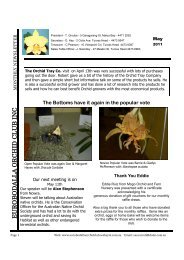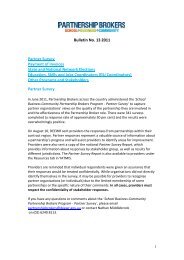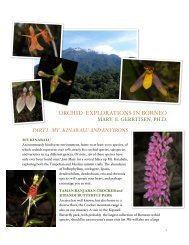Orchid Growing Substrates
Orchid Growing Substrates
Orchid Growing Substrates
Create successful ePaper yourself
Turn your PDF publications into a flip-book with our unique Google optimized e-Paper software.
unaffected themselves. It cannot be excluded that a lot of current knowledge about this material or<br />
that chemical becomes in the near or far future completely obsolete. Sometimes the practical results<br />
must be considered more than the current technical knowledge, as the knowledge changes all the<br />
time. How many people realize that only 30 years ago mobile phones with WIFI were science fiction,<br />
its technology could not even be imagined? In horticulture even, fungicides and bactericides, apart<br />
from copper and sulfur compounds are extremely recent newcomers, with some groups existing<br />
within only the last 15 years. Things are changing, and one needs to interpret and analyze everything<br />
using technical knowledge, and experience, which cannot yet be replaced by knowledge or studies.<br />
Potting material specifications<br />
We will now see some aspects and groups of potting materials, and some of their specificities, as well as some<br />
short histories about them.<br />
Rockwool<br />
- Rockwool has been popularized for a few decades. At first, it was a byproduct of the insulation<br />
industry. Rockwool was discovered and imagined because around some volcanoes, especially in<br />
Hawaii, there were sometimes some samples of wool like stone structure. This gave the idea to make<br />
Rockwool, known under several other names, stonewool, lava wool and many others. The<br />
manufacturing process of a large part of Rockwool allows the use of lime/calcium carbonate blended<br />
with the fused rock, which will help to make the spinning process, and the fiber production.<br />
Depending on the production site, sometimes recycled Rockwool is fused again, or other types of<br />
stones and rocks are added. This has dramatic consequences, that forced even one major supplier to<br />
ask for changes in the EU regulations in the 90’s to accept as a fact that Rockwool can have a high<br />
content of heavy metals, mercury and lead being specifically named. According to some studies made<br />
in Holland at that time, the heavy metals would not be released when it is used for horticulture, but it<br />
can never be really predicted or proved. Nevertheless, Rockwool used to be traded with levels of<br />
heavy metals deemed unacceptable in a normal organic potting mix. It can contain for some sources<br />
as well iron, manganese, chromium, zinc, boron and other elements in soluble and insoluble forms.<br />
At a point, the blending that was required of lime and rock to make the fiber would produce fiber that<br />
has a lot of bonds too with calcium hydroxide (the result of heating the lime). When Rockwool is used<br />
with an acid irrigation, that calcium hydroxide will be dissolved, a requirement especially with the<br />
newer, cheaper types of Rockwool, to flush it. In doing so, it leaves ‘gaps’ in the Rockwool structure<br />
and can precipitate its demise. One type of Rockwool cube would be reduced to sludge if left in water<br />
with hydrochloric acid at a pH of 4.5. At a higher pH, like 5.7, it is clear something would be released,<br />
and its structure would change. It is also proof if needed that Rockwool is not ‘inert’. In the 90’s a<br />
commercial blend named Greenmix, containing lignin blended with water absorbent and water<br />
repellent Rockwool, was very popular, and earned Eric Young <strong>Orchid</strong> Foundation its reputation, under<br />
the auspices of a very skilled grower, Alan Moon. It was not easy to use, even if one of us used it for<br />
some years (Xavier), and after some years would become ‘old’. Alan Moon said after 2-3 years<br />
roughly. Again a proof that it was not so ‘inert’. That blend disappeared from the market , so did most<br />
of the water absorbent and water repellent types of Rockwool, which was explainable, as the water<br />
Xavier Garreau de Loubresse<br />
6
















